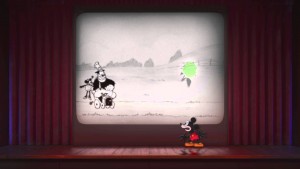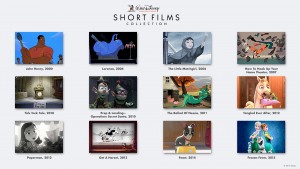Interview: Disney Animator Dorothy McKim on the Disney Short Film Collection
Posted on August 7, 2015 at 3:26 pm

Dorothy McKim produced one of my favorite of the recent Disney short films, “Get a Horse,” which brought old-time Mickey Mouse into the era of 3D CGI with an eye-popping, with a hilariously intricate choreography that literally jumps out of the screen. She talked to me about the making of the film and the new Blu-Ray release, Walt Disney Animation Studios Short Films Collection, available on August 18, 2015. McKim has been with Disney for 35 years, and she admits that her favorite Disney character is Dopey. ” I love that he doesn’t have to say a word and communicates perfectly fine.”
“Oh my golly, I love the shorts,” she told me. “I love the whole shorts program that we have here at Disney. We do them for a couple of reasons. We do it to test the director, to give a chance to the director pool, the director talent, and also to test the technology. And, it also allows a filmmaker to tell a short story in a very short amount of time. You got to get a lot of information in within 3-5 minutes, whether you do that through dialogue, through action, and also through the music. There’s such a diverse group of shorts, it just shows the kind of talent that we have here at the studio.” The old-fashioned images and animation in “Get a Horse” are all brand new footage. “Back in 2012, Disney wanted to bring back Mickey Mouse, like ‘Hey, let’s do some Mickey Mouse shorts.’ And it could be for for TV or it could be for the Disney Channel. We had about 30 people come forward with ideas. And what we did is that we culled that down to the top ten and we got those in front of John Lasseter. And what happened was that Lauren MacMullan, the director of “Get a Horse!” was pitching the idea. And we were in a room, and the pitch got to Lauren’s turn and she had one image that was up on the board and she had a black cloth in front of that and she said, ‘I have this idea for a Mickey short, but it’s a theatrical idea, it’s not an idea for TV.’ And she said, ‘I would love to take the hand-drawn characters, classic characters, keep them in black and white, and then they punch through a screen, and when they punch through the screen, they’re in color, and they’re in CG.” And she pulled down the black cloth, and it was an image of the classic characters in black and white, with Mickey’s foot punched through the screen, and his foot was CG and it was in yellow. And John Lasseter said, “I want to make that short.” It was the fastest pitch I have ever seen-—literally no more than ten minutes. It was that simple. And what we did was when we first started working on it, we thought it would be really great if we put it out into the world that we found this old footage and we wanted to build on it. And so we had that story going for us for a while, and then we started thinking, ‘Is this going to work against us?’ And I think it did a little bit with the Academy. It was all brand new footage. We had our own hand-drawn animators who worked on it, along with our CG. It was really great to watch both two groups come together on this short and it was the most fun thing I’ve ever worked on.”
It is not just the look of the characters that goes back to their original cartoons in the 1930’s. It is the way they move as well. “That’s called rubber horse animation,” McKim said. “We had Eric Goldberg, who was our head of animation, and he is just the best historian. He really brought that rubber horse animation that’s got their arms squashed and stretched. We did a lot of research. The lighting that we would use, what we did is we put the whole film through a rough patch, like going through and scratching it and making it look old. You know, back when they shot those shorts, they would do them in a little studio, and the reason why it looks like the lights are flickering was just that, their lights were flickering. We put a whole rough patch onto it and made it look like there were scratches on there and the lights were flickering. With the sound, we wanted that “Turkey in the Straw” that you hear in the beginning. We wanted the original one; we couldn’t get it because the people that made it, nobody is alive anymore, so we couldn’t find it. So we recreated it. Even with the sounds of an ocarina. Like little tiny whistles, right? We found an ocarina player and he came and put that in. So we really tried to make it authentic. As far as the sound effects, we actually used a lot of the original sound effects. We have an entire library that Jimmy McDonald built back in the day. They kept it, it’s with Walt Disney Imagineering, and we went over and actually used some of the instruments that Walt used. So it was all authentic.”
The most authentic sound in “Get a Horse” is Mickey’s voice, which was taken from recordings of the original actor who provided Mickey’s voice — Walt Disney himself. “It was really important for us to use Walt’s voice. So that’s 100% Walt’s voice. We had a screening for John Lasseter while we were making the work-in-progress, and Lauren and I were so excited. We pulled all of Walt’s dialogue from different shorts and we put it in into the short, and we’re so happy. And he’s like, ‘Oh wow, that’s so great! We’re going to use Walt, we’re not going to bring anyone else in, we’re going to use him.’ So we screened it, and John Lasseter, he’s brilliant, goes, ‘That was Walt except for the word red.’ And we kind of looked at it and we thought, ‘Shoot, we got caught.’ That one word, red, we couldn’t find anywhere in the library. We searched high and low. It took forever, about six months, to see if we could find the word red, and John found it. And we were like, ‘Oh man, you caught us,’ and he said, “’I could tell that wasn’t Walt,’ and we thought, ‘Man, he’s good.’ We really wanted to keep true to what our journey was. So we found a really great sound designer who worked with our editorial team, and they found three syllables that Walt said, an Rr, an Eh, and a Duh, to form the word red, and that’s three syllables from three different words that he used. They formed it and we put it together and they made it seamless. So that’s 100% Walt’s voice.”
McKim said that what Mickey and Disney had in common was “taking risks. He took risks. Walt, when he did his shorts and used Mickey. And Mickey took risks. Some of those old shorts, “Plane Crazy,” jumping out of a plane, you know, he wasn’t afraid. And I think that’s what we wanted to keep true to what Walt was doing with Mickey, and I felt like we really accomplished that in ‘Get a Horse!’”
